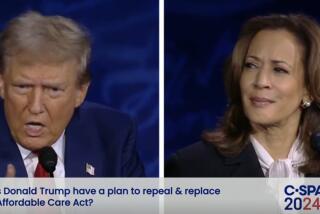After Decades of Debate
- Share via
For most of the 20th century, Americans have been debating how to guarantee health care to everyone while controlling costs. President Clinton is only the latest in a long line of national leaders who have grappled with this issue. The history of this political struggle began early in the century, when Europe was marching toward national health insurance even as private insurance became the rule in the United States.
1910s
1910--Montgomery Ward & Co. establishes what is generally regarded as the first group health insurance policy.
1911--Britain becomes the last major European country to enact national health insurance.Germany had adopted the first such system in 1883.
1916--Sixteen state legislatures consider a labor-sponsored plan for government health insurance. It has the backing of American Medical Assn. but is opposed by labor leader Samuel Gompers, left.
1918--In a wartime climate, a proposal for compulsory health insurance is defeated in a California referendum by a vote of 358,324 to 133,858.
1920s
1929--The nation’s first HMO, the Ross Loos Clinic, is founded in Los Angeles.
1930s
1932--A group of hospitals in Sacramento establish the nation’s first citywide Blue Cross plan.
1935--President Franklin D. Roosevelt signs the Social Security Act, which includes financing of medical benefits for the elderly.
1940s
1941---During World War II, when wages are frozen, group health insurance becomes an important element of collective bargaining between unions and companies.
1943--The Murray-Wagner-Dingell bill, the first such measure proposing national health insurance, is introduced in Congress.
1945--Three months after the end of World War II, President Harry S. Truman asks Congress to pass a national program to provide health-care security for every American.
1950s
1956--Congress adds disability insurance to the Social Security system, providing monthly cash benefits for insured persons who become totally disabled.
1960s
1965--President Lyndon B. Johnson signs into law the Medicare program, which provides federal health insurance for all persons 65 and older. Medicaid, providing health care for the poor, is enacted during the same year.
1970s
1973--The Health Maintenance Organization Act is signed into law by President Richard M. Nixon, setting a framework for establishing more HMOs.
1974--Congress establishes a network of federal agencies to control health costs. More than 20 health insurance bills are introduced in Congress, but none passes.
1979--President Carter unsuccessfully proposes a national health insurance plan.
1980s
1981--Under President Ronald Reagan, the government begins restricting federal health care expenditures and shifting responsibilities to the states.
1985--Congress requires employers to offer retirees and other terminated employees the opportunity to continue participating in company health plans at their own expense for 18 months.
1988--Congress modifies the Medicare program to protect the elderly from financial ruin as a result of catastrophic illness.
1989--Faced with a public outcry over the tax increase necessary to finance Medicare’s catastrophic illness coverage, Congress repeals the program.
1990s
1991--Chrysler, Lockheed, Xerox and other major employers endorse “pay-or-play” legislation, which would require all companies either to provide health insurance for their employees or to pay into a government fund that would finance insurance for the uninsured.
1992--President Clinton is elected on a promise to reform the nation’s health-care system.
A Growing Burden: National health expenditure as percent of GNP 1950: 4.4% 1960: 5.3% 1970: 7.3% 1980: 9.1% 1990: 12.2%
More to Read
Sign up for Essential California
The most important California stories and recommendations in your inbox every morning.
You may occasionally receive promotional content from the Los Angeles Times.










